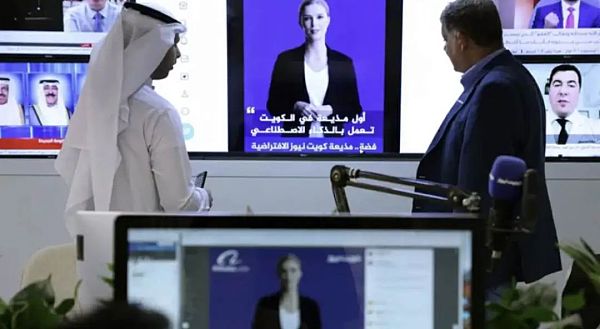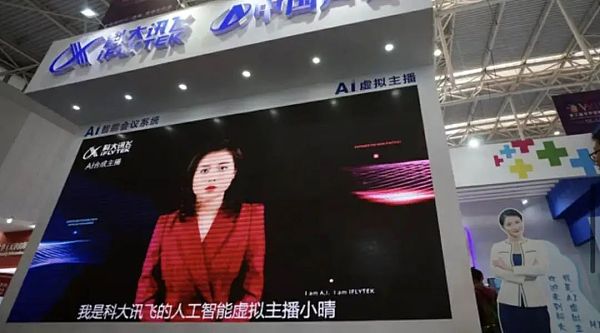Source: Heart of the Metaverse
A startup is developing a news service broadcast by AI hosts Will this subvert decades of television? The relationship between the audience and the on-screen host?
These shots would not be out of place on many news channels around the world.
A video posted on social media showed that for 22 minutes, various carefully modified news anchors stood in front of the camera and broadcast the news of the day. But none of them are real, but generated by AI.
The video was produced by Channel 1, a Los Angeles-based company founded by entrepreneurs Adam Mosam and Scott Zabielski, which plans to launch it on the streaming TV channel later this year AI-generated news .
Mosam said: “There seems to be an interesting opportunity to use AI to tailor content to individuals to improve the news user experience.”

AI technology can also translate scripts and interviews from one language to another Language Channel 1 showed off these features in a promotional video shared in December.
Channel 1 is the latest demonstration of global AI news anchors . In Kuwait, an AI character named "Fedha" delivers headlines for Kuwait News.
In May 2023, the Greek national broadcaster ERT will use the AI-generated deep virtual human Hermes to conduct news releases; South Korea's SBS Broadcasting Company will hand over five months of news broadcasting work to the AI-generated Character Zae-In; similar applications exist in India and Taiwan.
But a key question remains to be answered: Will audiences trust news provided by AI rather than humans
Trust in newscasters has fallen to an all-time low, according to a survey by polling firm Ipsos.
Only 42% of people in the UK trust TV newscasters , a drop of 16 percentage points in one year. Doubting newscasters as independent arbiters of truth is an unusual modern phenomenon, with many people choosing to get their news from individual creators or online bloggers.
These connections between social media influencers and their audiences are known as “parasitic social influence”
Parasitic social relationships were first proposed by scholars at the University of Chicago in the 1950s. It is defined as: viewers watching the evening news program believe that the anchor standing behind the desk is speaking through the camera. Talk to them directly. News anchors are no longer just reporters delivering the news, but friends to their viewers, spending time with them in their living rooms every night.
Influential social media influencers have also adopted this direct-to-camera format and connected with their audiences through charisma, with great success.
Christine H Tran, who studies digital platforms and labor at the University of Toronto, said: "Interestingly, the 'parasitic society' label has evolved from describing an individual's affinity for remote news anchors to a broader stuff.”
“You can have a parasitic social relationship with a journalist or a news Twitch streamer, just as much as you can have a parasitic social relationship with a YouTube star, a singer, or an Instagram couple. .”
But whether AI can replicate personal connections is less certain Mosam admitted: "The connection between you and AI will never be the same as the connection between you and another human being." However, Mosam also said: "We do not develop AI news broadcast services this way because we think It's ridiculous that robots can do better than humans."

The idea that journalists don’t read the news is not unusual, even if the news is computer-generated.
Nic Newman, a senior research associate at the Reuters Institute for Journalism at the University of Oxford and a former editor at the BBC, said: "When I first started working in journalism, the news was delivered by actors and people were okay with it. Acceptable." Newman believes that reporters don't always read the news, which means the trial is likely to be successful. But it also has limitations and is only useful for short news briefings.
But Newman also said that he is not sure whether viewers will accept a relationship with an AI anchor. After all, for news programming, humanity is still very important
This is also something Tran is unsure about. "If broadcasts of AI characters were accurately labeled 'AI content,' and viewers knew they had no personal lives outside of the screen, would they inspire the same parasitic sociality?"
" It depends on whether platforms hosting AI presenters will label their content as AI, as some platforms such as Instagram have considered.”
Channel 1 and NewsGPT claim to be the first in the world to be entirely hosted by AI-generated news channel, but perhaps there is another question that needs to be answered: Is it possible to completely eliminate human involvement?
Currently, Channel has nearly ten staff members responsible for checking AI-generated scripts and selecting the news that should be reported.
Mosam said that Channel 1 goes through 13 steps before each report is broadcast to ensure that some issues related to AI generation are not broadcast. These include “pseudo-facts,” in which AI tools make things up, which is an obvious no-no in journalism. The company behind it is preparing to hire an editor-in-chief early next year.
Mosam and Newman believe that being able to actually find newsworthy events and report on them is another difficulty that AI may face. Channel 1’s test programming relies heavily on stories unearthed and footage captured by human journalists
Newman said: "If these sources are not available, or these sources are cut off, I really can't think of how AI can find newsworthy events. If there is no such raw material, then AI will There is absolutely no way to start."
Mosam believes: " Some elements of the reporting process can be completed by AI , but other elements cannot be achieved." p>
He said: "You can never effectively gather intelligence from person to person, and you can never effectively interview people from person to person. But I can fly a drone and analyze everything I see. ”
News gathering entirely by AI, without human participation, is not in Channel 1’s current plan.
 JinseFinance
JinseFinance
 JinseFinance
JinseFinance Others
Others Darren
Darren Coinlive
Coinlive  Bitcoinist
Bitcoinist Nulltx
Nulltx Nell
Nell Cointelegraph
Cointelegraph Cointelegraph
Cointelegraph Cointelegraph
Cointelegraph